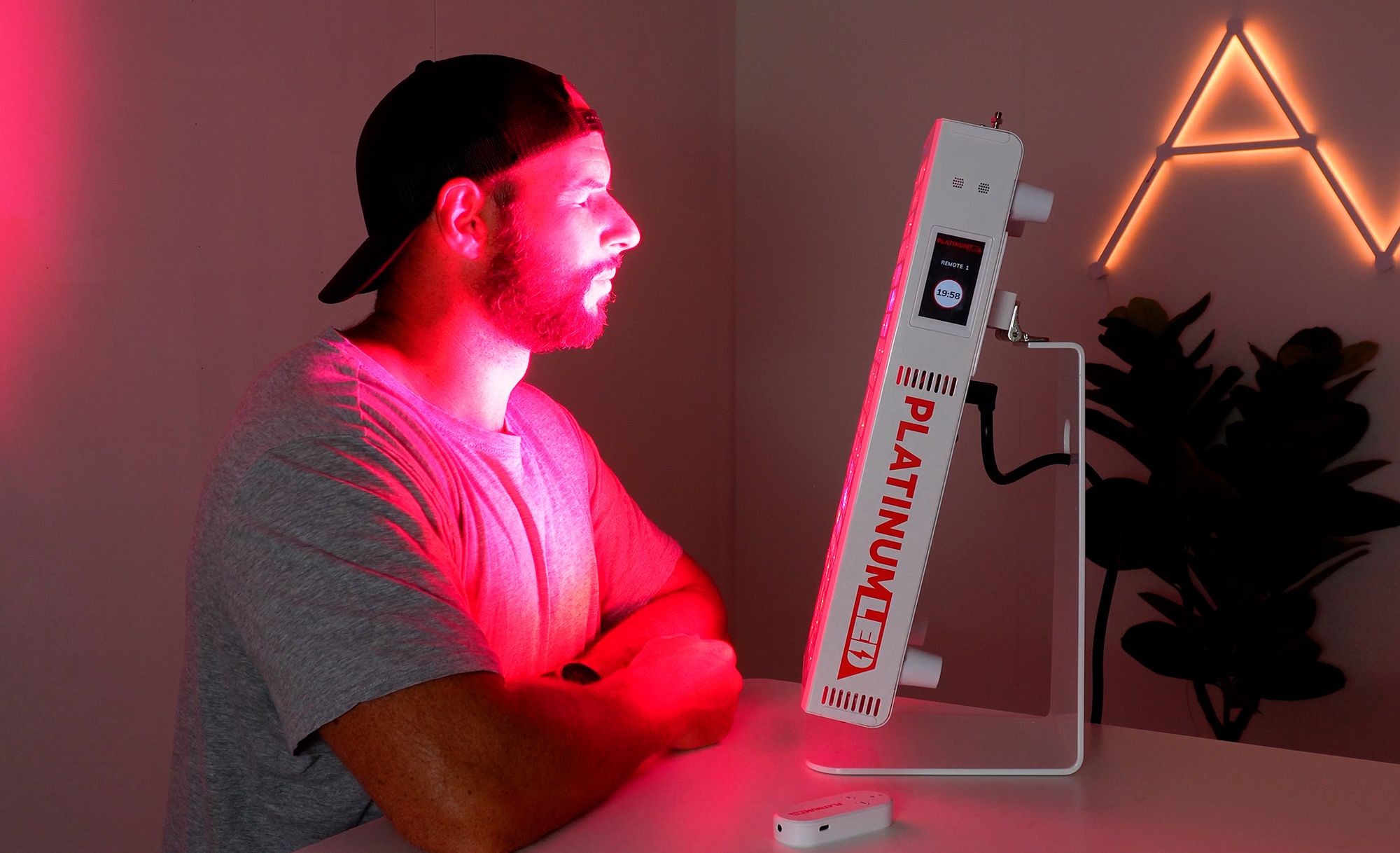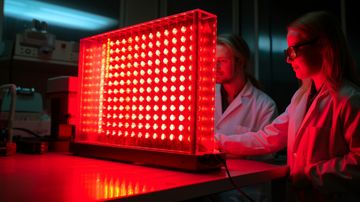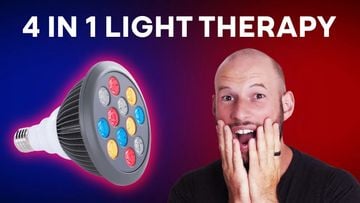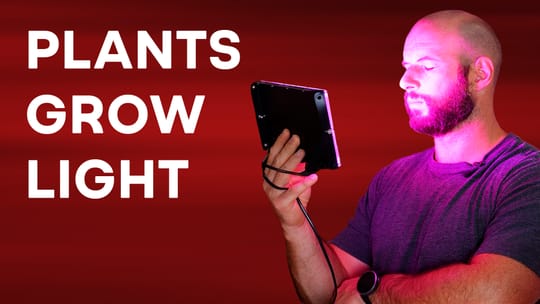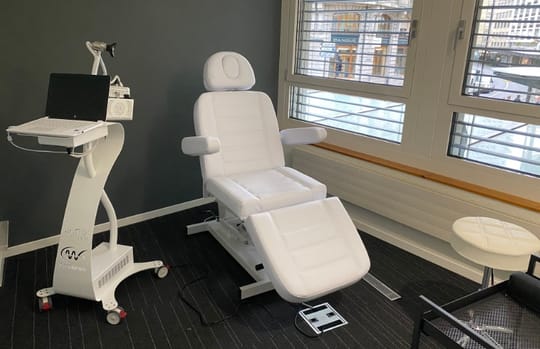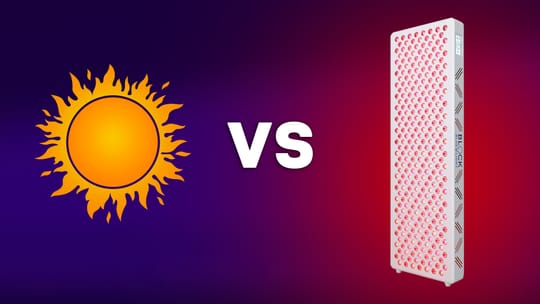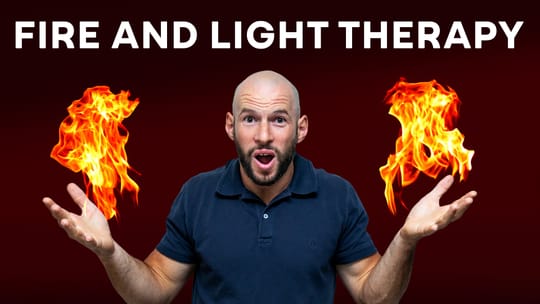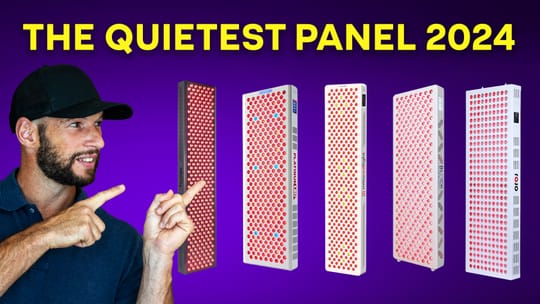In this blog post, I'll tell you how to use red light therapy at home. I've got many years of experience on this topic, helping clients with how to do red light therapy at home and as a science writer.
In this blog post, I'll tell you step by step about the benefits of using red light therapy at home, some fascinating success stories from people, how to select a device, treatment protocols, and more.
But first, let's start with the obvious - the benefits of using red light therapy at home:
The Benefits Of Using Red Light Therapy At Home
In this section, I'll explain six different benefits of using red light therapy at home:
#1: Saving Time And Money!
The most obvious benefit here is that you're saving tons of time and money. You don't need to spend 20 or 40 minutes traveling to a red light therapy clinic. And you don't need to pay a high fee to use red light therapy.
Depending on where you live, a red light therapy clinic can cost you between $10 and $100 USD - money that you will save by having a device in your house.
#2: Anti-Aging While Reversing The Signs Of Aging Biologically
Many different theories on the biological mechanisms of aging exist (1; 2; 3; 4). Red light therapy affects many of these mechanisms. I'll explore a few of these mechanisms here.
First up, red light therapy affects so-called "oxidative stress" at many different levels (5; 6; 7; 8; 9). Oxidative stress is a byproduct of energy production in the human body but also directly causes aging. And while I'm oversimplifying here, with age, oxidative stress and its negative effects tend to go down. Red light therapy lowers that oxidative stress.
Secondly, anther mechanism by which red light therapy has anti-aging benefits is by lowering systemic inflammation (10; 11; 12; 13; 14). Excess inflammation is tied to many health conditions that people develop with age, such as heart disease, diabetes, neurological problems, and more.
Lowering inflammation and stress, in turn, also improves energy production. Other mechanisms exist as well by which red light therapy increases energy production at the cellular level (15; 16; 17; 18). I won't go into these right here but suffice it to say that red light therapy has many different mechanisms to counter the aging process.
And, these results also lead to cosmetic improvements that many people are so interested in:
#3: Counters Fine Lines And Wrinkles While Improving Wound Healing
Many different studies in both humans and animals show that red light therapy stimulates collagen production in the skin (19; 20; 21; 22; 23; 24; 25: 26). The same is true for wound healing (27; 28; 29; 30; 31; 32; 33).
For instance, one study got the following results for wrinkles:
"here was a significant reduction in wrinkle volume after red (31.6%) and amber (29.9%) [red light therapy] None of the treatments improved skin hydration and viscoelasticity." (25)
And that study just used ten treatments over a period of four weeks. With more frequent treatments, you can get even better results in that study. Many people using red light therapy tend to find that their overall skin quality improves dramatically over time.
If you're interested, make sure to watch some of the videos on this topic, such as:
Are you curious about whether red light therapy works for countering fine lines and wrinkles? Check out this before and after video by Alex Fergus who tested a red light therapy face mask for skin health for five weeks!
Also, you may want to know about affordable red light therapy for beauty devices:
If you're interested in a red light therapy device for beauty specifically, check out this video
Next up:
#4: Quicker Workout Recovery And Enhanced Athletic Performance
Quite a few studies have investigated the effects of red light therapy around workouts in humans, and most of them are positive (34; 35; 36; 37; 38; 39; 40; 41; 42).
And you won't get any side effects, just quicker recovery and enhanced performance. Some online sources have gone as far as to consider red light therapy doping, and questions have emerged about banning the treatment.
Near-infrared light may work slightly better than red light for sports, as it penetrates deeper. Generally, the best time to use red light therapy is a few hours before your workout.
And, for the best results, you'll want to treat most of your body to get a full-body effect. You'll also want a higher-powered device as higher doses work better for athletic performance.
Check out this video below if you want to learn more:
Here you learn everything you need to know about using red light therapy for athletic performance
#5: Enhanced Well-Being With Lower Anxiety And Depression Risk
Next up, red light therapy is very helpful for mood and well-being too. Quite a few animal and human studies have explored the effects of red light therapy for countering major depression and anxiety (43; 44; 45; 46; 47; 48; 49; 50; 51).
For instance, a recent 2019 review study claims the following - which may be interesting if you're a health geek:
"Red and [near infrared] light penetrate the skull and modulate brain cortex; an indirect effect of red and NIR light, when delivered non-transcranially [i.e., through the skull], is also postulated. The main proposed mechanism for [red light therapy] is the enhancement of mitochondrial metabolism after absorption of [near infrared] energy by the cytochrome C oxidase; however, actions on other pathways relevant to [Major Depressive Disorder] are also reported. Studies on animal models indicate a benefit from [red light therapy] that is comparable to antidepressant medications. Clinical studies also indicate a significant antidepressant effect and good tolerability." (43).
So, if you've got major depressive disorder, you can use red light therapy side by side. And, overall effect on depression and anxiety are very significant. Anecdotally, users also report feeling more energetic and a very calm focus and relaxed increase of energy, like you'd get after a great meditation session.
Next up:
#6: Lowers Overall Disease Risk
I've touched on the risk of a few health conditions already. But, as it turns out, red light therapy can lower overall disease risk in many cases:
- has very significant effects on many different types of (chronic) pain (52; 53; 54; 55; 56; 57; 58; 59). Knee pain, lower back pain, peripheral nerve pain, all come to mind here.
- very likely counters neurodegenerative diseases such as Alzheimer's and Parkinson's disease (60; 61; 62; 63; 64; 65; 66). More human research is needed here but the results are very promising already.
- improves glucose management by the body, meaning that your risk of diabetes may come down (67; 68; 69; 70; 71). Again, more human research is needed but preliminary results are very promising. Cells are much more likely to take up glucose in the muscle instead of storing it as body fat, for instance.
- can improve eye health, such as with age-related macular degeneration (72; 73; 74; 75; 76).
And many other areas that I won't cover here.
Don't believe me? Let's explore a few real-life success stories using red light therapy at home:
Real-Life Success Stories
In this section, I'll cover some real-life success stories using red light therapy. I'll take many of these success stories from the video posted below, wherein Alex Fergus collects testimonials from users:
Here's a great video in which Alex Fergus explores the many different success stories and testimonials that different people gave after using red light therapy. Alex covers benefits such as countering pain, improving skin health and wound healing, overall health benefits, respiratory and brain health, and more!
These testimonials are sourced from people who have commented on many of our red light therapy YouTube videos. Here are some examples:
"I don't have a lot of money but I got a small square [red light therapy product]. It is the most effective thing ever. I have two bad hips [with] bone on bone [interactions]. And [I have] plantar fasciitis. Nothing works but this. It's truly a blessing. I wish to God I could get a big one one day"
Obviously, that's a person who got life-changing results with red light therapy. And there are many more testimonials like that:
"And, as an aside, red light/[near infrared light] has helped my hypothyroid so my dosage has lowered from .75 to .50. My hubs who is the biggest skeptic in the world has found great relief on an arthritic knee. As he said "my knee doesn't hurt when I walk downstairs". Again, I don't work for [this red light therapy company].. I just swear by their products"
And one last success story:
"I bought the Neuronic helmet for my wife who has been diagnosed with Alzheimer's. We also have the consultation which is very helpful. This is not a cure but has made the life better for both of us. We have been using it for almost two months. In that time my wife's mood has improved and she is able to do daily tasks. I use the helmet as well and I think my mood is better, but this is hard to prove. We have a lot less fights than we had before. Her memory is far from good, but she is less frustrated than in the past. I figured what do we have to lose?"
As you can see, many people have very impressive success stories with red light therapy. If you want to know more, check the before and after video I mentioned earlier.
Selecting The Ideal Red Light Therapy Device
Selecting the ideal red light therapy device can be complicated because of many factors influencing it. In the video below, Alex Fergus explains 15 of these factors:
If you want more tips on how to select the perfect red light therapy device at home device, check out this buyer's guide where Alex Fergus gives you 15 different criteria on what to look out for!
A few of the most important factors are:
- The treatment area that the device affects. Handheld red light therapy devices are great for spot treatments, for instance. But if you want to treat bigger areas of the body, you'll need a bigger device.
- Budget. Bigger devices cost more but there can be a huge difference in price between products that are about the same quality. For that reason we're reviewing products on this website.
- Wavelengths are the type of light emitted from red light therapy devices. Common red light wavelengths are 630 and 660 nanometers, for instance. Wavelengths have unique effects so if they're not emitted by a product, you won't get their benefit.
- Power output is the quantity of light emitted. In other words, how many photons of light are projected onto your body. Higher powered devices generally have a shorter treatment time and allow the red and near infrared light to penetrate deeper.
If you want to learn more, check our YouTube video on a red light therapy buyer's guide or our blog on buying a red light therapy device.
How To Set Up Your Red Light Therapy Space
In most cases, you don't necessarily need a red light therapy space. For instance, very little space is needed if you've got a handheld red light therapy device, a tabletop panel, a mask, or even a full-body panel that can be placed vertically in a room.
In some cases though, you may need to set up a space. Examples here are when you're using a red light therapy bed or when using a horizontal stand with red light therapy panels. As you can imagine, a bed or horizontal stand with multiple panels take up a lot of space. Hence, in these cases a dedicated space can be helpful.
In most other situations, though, you can simply use the products in your bedroom, garage, living room or another space.
Red Light Therapy Protocol Ideas
Red light therapy protocols are a very complex topic for the average person. For that reason, I recommend following the instructions that almost all companies offer with their product. We've tested dozens if not over a hundred products and in all cases you get an instruction manual explaining how to use the product.
If you do want to optimize your red light therapy protocol, however, read the advanced section below:
Let's assume a red light therapy device emits 50 mW/cm2 on a given area. In one minute, that device gives you a dose of 50 mW/cm2 * 60 seconds = 3,000 mW/cm2 = 3 J/cm2.
Although both scientists and red light therapy influencers disagree about dosing protocols and it's a very hot topic, a guideline dose for superficial tissues such as the skin is 5 J/cm2 and for deeper tissues 30-60 J/cm2.
To get to that 30 J/cm2 dose with the device I've mentioned above, you'd need to treat yourself for 10 minutes on that area.
How Long Should You Do Red Light Therapy?
Many people ask "How long should you do red light therapy?" The answer here is "It depends" - in the same way there's no universal exercise protocol that's correct for everybody.
The device you use, the area you want to treat, and your goals (whether it's a superficial tissue or deeper tissue) matter a lot for the treatment time. Once again, it's best to follow the instructions of the manufacturer of the device as they almost always supply you with treatment protocols.
However, if you really want to know the ins and outs of this topic, use the red light therapy dosing instructions I left above. You'll also need to know the power output of your device, which is usually not accurately represented by red light therapy companies. For that reason we do independent testing of the power output (quantity of light) emitted by red light therapy devices.
What Is The Best Red Light Therapy Distance From Skin?
There's no best red light therapy distance from the skin, but usually, a distance of three to twelve inches is used. A higher distance decreases the amount of light that reaches your skin and is therapeutically less effective. A shorter distance increases the dosage and penetration, but also usually decreases the area that's affected.
Frequently Asked Questions
Below I'll answer a few other frequently asked questions about how to use red light therapy at home.
What’s the Best Time to Use Red Light Therapy?
There's no strict best time to use red light therapy. However, some people find that red light therapy at night is overstimulating. For those persons, it's better to use it during the daytime, such as the morning or afternoon.
Do You Need A Red Light Therapy Room?
No, you don't need a red light therapy room. Red light therapy will work just fine in any room, such as your bedroom, garage, living room, or another place. Be careful with placing a device in your bathroom though as the combination of water and electronics can be dangerous.
Can I Overdo Red Light Therapy?
A very common question I get a lot is "how much red light therapy is too much?" Normally, by following instructions that come with the device, you shouldn't overdo red light therapy.
But, technically, red light therapy can be overdone if you use a device longer than is recommended. In that case, the light will have an inhibiting effect and the health benefits will be impeded or absent.
Can You Use Red Light Therapy Every Day?
Yes, you can use red light therapy every day. However, anecdotally, many people have great results by doing five to six sessions per week and keeping one day off.
There's no hard science on this topic though as the research using LED full body products is limited.
Can You Do Red Light Therapy Twice Per Day
Generally, you can use red light therapy twice per day but it's not recommended. The risk of overdosing becomes significantly greater with twice-a-day treatments. Unless the instructions with your device recommend treatments twice per day, avoid this.
How Much Red Light Therapy Should I Do Daily?
For 99% of people, one daily red light therapy session is enough. Doing less than that will decrease your results and doing more also decreases your results.
How To Maximize Red Light Therapy Outcomes?
In most cases, you can just do the red light therapy throughout the day. Some people find that doing sessions at night can be overstimulating, so in that case the mornings, afternoons, or early evenings are better.
And, in some cases, such as for workout performance, it's best to do your sessions a few hours before you work out.
Can You Use Red Light Therapy For Eyes At Home?
I don't recommend staring directly into the light. Use protective eyewear if you have to face the light for a long period of time. Some of the red and near-infrared light entering your eyes is very supportive of eye health, however.
How To Make Red Light Therapy At Home
The answer is really simple here: you buy a high-quality device and start using it. Check out videos on how to make red light therapy at home with a tabletop panel or bigger devices.
Does Infrared Light Therapy Work Through Clothes?
Depending on the material, clothes block between 50% and 95% of the light coming through it. White clothes block less light than black clothes. For the best results, I recommend not wearing clothes on the area you're treating.
If you want to learn more about how clothing affects your treatments, check the video below:
In this video, Alex Fergus uses different experiments to show how much light is blocked by different fabrics such as clothes, towels, and more.
What To Do After Red Light Therapy?
After red light therapy, you should feel ready to conquer the day! There's nothing specific you need to do after red light therapy though.
Conclusion: DIY Red Light Therapy Has Never Been Easier
Red Light therapy at home can be done in varying ways, such as with a belt, handheld units, and wraps. But red light therapy panels offer the most value for most people and are very easy to use.
One daily session with as few clothes as possible will give the best results for most people. And, as companies have usually thought well about dosing parameters, I recommend following the instructions that come with the device. DIY red light therapy has never been easier!
This is a post by Bart Wolbers of Lighttherapyinsiders. Bart finished degrees in Physical Therapy (B), Philosophy (BA and MA), Philosophy of Science and Technology (MS - with distinction), and Clinical Health Science (MS), has had training in functional medicine, and is currently chief science writer.

